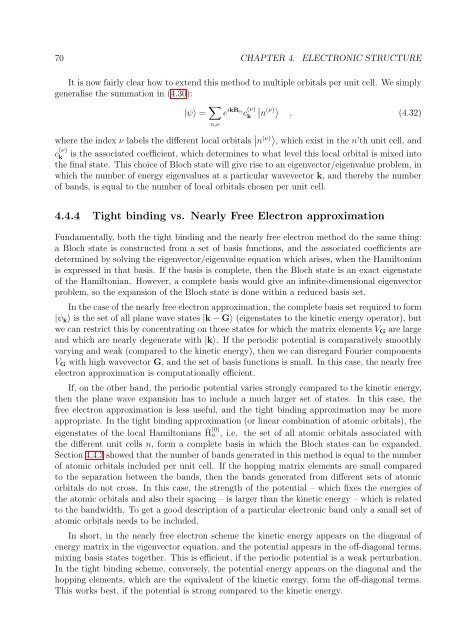Set of supplementary notes.
Set of supplementary notes.
Set of supplementary notes.
You also want an ePaper? Increase the reach of your titles
YUMPU automatically turns print PDFs into web optimized ePapers that Google loves.
70 CHAPTER 4. ELECTRONIC STRUCTURE<br />
It is now fairly clear how to extend this method to multiple orbitals per unit cell. We simply<br />
generalise the summation in (4.30):<br />
|ψ〉 = ∑ e ikRn c (ν) ∣ 〉 k n<br />
(ν)<br />
, (4.32)<br />
n,ν<br />
where the index ν labels the different local orbitals ∣ ∣ n<br />
(ν) 〉 , which exist in the n’th unit cell, and<br />
is the associated coefficient, which determines to what level this local orbital is mixed into<br />
the final state. This choice <strong>of</strong> Bloch state will give rise to an eigenvector/eigenvalue problem, in<br />
which the number <strong>of</strong> energy eigenvalues at a particular wavevector k, and thereby the number<br />
<strong>of</strong> bands, is equal to the number <strong>of</strong> local orbitals chosen per unit cell.<br />
c (ν)<br />
k<br />
4.4.4 Tight binding vs. Nearly Free Electron approximation<br />
Fundamentally, both the tight binding and the nearly free electron method do the same thing:<br />
a Bloch state is constructed from a set <strong>of</strong> basis functions, and the associated coefficients are<br />
determined by solving the eigenvector/eigenvalue equation which arises, when the Hamiltonian<br />
is expressed in that basis. If the basis is complete, then the Bloch state is an exact eigenstate<br />
<strong>of</strong> the Hamiltonian. However, a complete basis would give an infinite-dimensional eigenvector<br />
problem, so the expansion <strong>of</strong> the Bloch state is done within a reduced basis set.<br />
In the case <strong>of</strong> the nearly free electron approximation, the complete basis set required to form<br />
|ψ k 〉 is the set <strong>of</strong> all plane wave states |k − G〉 (eigenstates to the kinetic energy operator), but<br />
we can restrict this by concentrating on those states for which the matrix elements V G are large<br />
and which are nearly degenerate with |k〉. If the periodic potential is comparatively smoothly<br />
varying and weak (compared to the kinetic energy), then we can disregard Fourier components<br />
V G with high wavevector G, and the set <strong>of</strong> basis functions is small. In this case, the nearly free<br />
electron approximation is computationally efficient.<br />
If, on the other hand, the periodic potential varies strongly compared to the kinetic energy,<br />
then the plane wave expansion has to include a much larger set <strong>of</strong> states. In this case, the<br />
free electron approximation is less useful, and the tight binding approximation may be more<br />
appropriate. In the tight binding approximation (or linear combination <strong>of</strong> atomic orbitals), the<br />
eigenstates <strong>of</strong> the local Hamiltonians Ĥ(0) n , i.e. the set <strong>of</strong> all atomic orbitals associated with<br />
the different unit cells n, form a complete basis in which the Bloch states can be expanded.<br />
Section 4.4.3 showed that the number <strong>of</strong> bands generated in this method is equal to the number<br />
<strong>of</strong> atomic orbitals included per unit cell. If the hopping matrix elements are small compared<br />
to the separation between the bands, then the bands generated from different sets <strong>of</strong> atomic<br />
orbitals do not cross. In this case, the strength <strong>of</strong> the potential – which fixes the energies <strong>of</strong><br />
the atomic orbitals and also their spacing – is larger than the kinetic energy – which is related<br />
to the bandwidth. To get a good description <strong>of</strong> a particular electronic band only a small set <strong>of</strong><br />
atomic orbitals needs to be included.<br />
In short, in the nearly free electron scheme the kinetic energy appears on the diagonal <strong>of</strong><br />
energy matrix in the eigenvector equation, and the potential appears in the <strong>of</strong>f-diagonal terms,<br />
mixing basis states together. This is efficient, if the periodic potential is a weak perturbation.<br />
In the tight binding scheme, conversely, the potential energy appears on the diagonal and the<br />
hopping elements, which are the equivalent <strong>of</strong> the kinetic energy, form the <strong>of</strong>f-diagonal terms.<br />
This works best, if the potential is strong compared to the kinetic energy.








